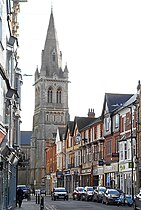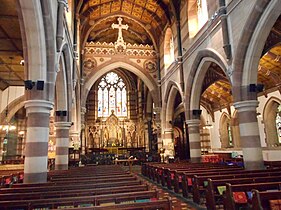
The Church of St Mary the Virgin, widely known as St Mary Redcliffe, is the main Church of England parish church for the Redcliffe district of the city of Bristol, England. The first reference to a church on the site appears in 1158, with the present building dating from 1185 to 1872. The church is considered one of the country's finest and largest parish churches as well as an outstanding example of English Gothic architecture. The church is so large it is sometimes mistaken for Bristol Cathedral by tourists. The building has Grade I listed status, the highest possible category, by Historic England.

St Bartholomew's Church is a parish church of the Church of England Diocese of Truro in Lostwithiel, Cornwall, England, United Kingdom.

The Church of St James and St Paul, south of the village of Marton, Cheshire, England, is recorded in the National Heritage List for England as a designated Grade I listed building. It is an active Anglican parish church in the diocese of Chester, the archdeaconry of Macclesfield and the deanery of Congleton. Its benefice is combined with those of Holy Trinity, Capesthorne, Christ Church, Eaton, and All Saints, Siddington. The church is an important location in the novel Strandloper by Alan Garner.

St Mary's Church in Cheadle, Greater Manchester, England, is a Grade I listed building. It is an Anglican parish church in the diocese of Chester, the archdeaconry of Macclesfield and the deanery of Cheadle. Its benefice is united with that of St Cuthbert.
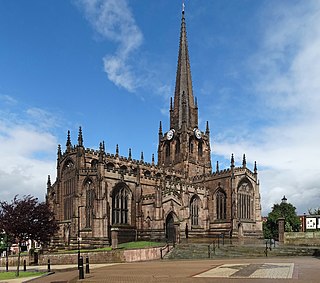
The Minster Church of All Saints or Rotherham Minster is the Anglican minster church of Rotherham, South Yorkshire, England. The Minster is a prominent example of Perpendicular Gothic architecture and various architectural historians have rated it highly. Nikolaus Pevsner describes it as "one of the largest and stateliest churches in Yorkshire", Simon Jenkins states it is "the best work in the county", and Alec Clifton-Taylor calls it the "glory of Rotherham". With its tall spire, it is Rotherham's most predominant landmark, and amongst the tallest churches in Yorkshire.

St Alphege Church, Solihull, is a medieval parish church in the Church of England in Solihull, West Midlands.

St Patrick's Church, Patrington is an Anglican parish church located in Patrington, East Riding of Yorkshire, England. The church is a Grade I listed building.

The ParishChurch of St Mary, more commonly known as St Mary's, is the main Church of England parish church for the town of Bridgwater, Somerset. Originally founded well before the Norman Conquest, the present church is a large and imposing structure dating primarily from the 14th and 15th centuries, with both earlier remains and later additions.

St Bees Priory is the parish church of St Bees, Cumbria, in England. There is evidence for a pre-Norman religious site, and on this a Benedictine priory was founded by the first Norman Lord of Egremont William Meschin, and was dedicated by Archbishop Thurstan of York, sometime between 1120 and 1135.

St. Michael the Archangel Church is the oldest building still in use in the city of Southampton, England, founded in 1070. It is the only church still active of the five originally in the medieval walled town. The church is a Grade I Listed building.

St Mary's Church in the village of Purton in north Wiltshire, England, is an active Church of England parish church in the Diocese of Bristol. A large building begun in the 13th century and one of only three churches in England to have both a western tower and a central spire, it has been designated as a Grade I listed building by English Heritage.

St. Peter and St. Paul, known commonly as Dagenham Parish Church, is a Church of England parish church in the London Borough of Barking and Dagenham, England, formerly part of Essex. It is of medieval origin, largely rebuilt at the beginning of the nineteenth century.

St Mary Magdalene's Church is located in Church Street, Clitheroe, Lancashire, England. It is the Anglican parish church of the town, and is in the deanery of Whalley, the archdeaconry of Blackburn, and the diocese of Blackburn. The church, dedicated to Jesus' companion Mary Magdalene, is recorded in the National Heritage List for England as a designated Grade II* listed building.
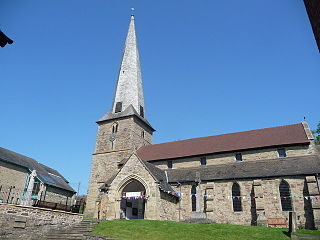
St Mary's Church is on Church Street, Cleobury Mortimer, Shropshire, England. It is an active Anglican parish church in the deanery of Ludlow, the archdeaconry of Ludlow, and the diocese of Hereford. Its benefice is united with those of six local parishes to form the Cleobury Benefice. The church is recorded in the National Heritage List for England as a designated Grade I listed building. It is notable for its shingled twisted spire.

The Church of St John the Evangelist is a Grade I listed Church of England parish church dedicated to John the Evangelist, in Corby Glen, Lincolnshire, England. The church is 9 miles (14 km) south-east of Grantham, and in the South Kesteven Lincolnshire Vales. It is noted in particular for its 14th- and 15th-century medieval wall paintings.

The Church of St Mary the Virgin is a parish church of the Church of England in Baldock in Hertfordshire. Dedicated to the Virgin Mary, the original church on the site dated to about 1150 and was built by the Knights Templar before being largely rebuilt in about 1330 by the Knights Hospitaller. It is a Grade I listed building.
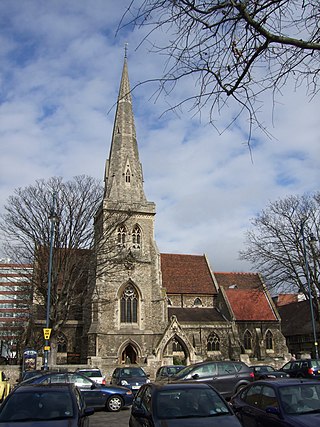
The Church of St Edward the Confessor is an anglican church in Romford, in the London Borough of Havering, England. It is part of the Diocese of Chelmsford. The building dates from 1849–50 and replaced an earlier church which was demolished in the mid-19th century. There has been a religious building on the site since the end of the 14th century. The current church was completed to a gothic revival design by the English architect John Johnson. It was designated as a Grade II* listed building by English Heritage in 1952.

St James's Church is the main Church of England parish church for the town of Trowbridge, Wiltshire, England. The 15th-century Grade I listed building is the town's most prominent landmark.

St Winnow's Church, St Winnow is a Grade I listed parish church in the Church of England in St Winnow, Cornwall.

The Church of St Mary the Virgin is the main Church of England parish church for the village of Uffculme, Devon, England. First mentioned in a charter dating back to 1136, the present church has a mixture of medieval and Victorian architecture and is a Grade II* listed building. The church building is notable for its rood screen, the longest and oldest in the county, as well as its tall broach spire, a rare feature on churches in Devon.


